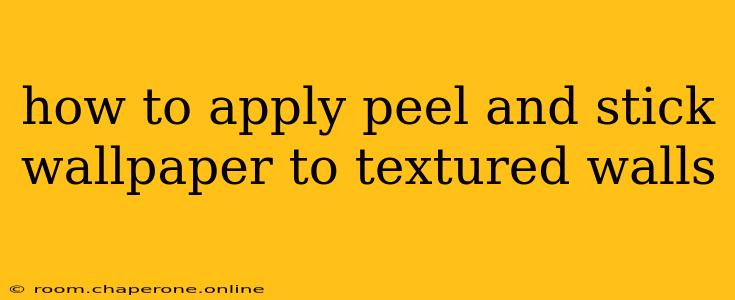Applying peel and stick wallpaper to textured walls presents a unique challenge, but with the right preparation and technique, you can achieve a professional-looking finish. This guide will walk you through the process, offering tips and tricks for success, even on heavily textured surfaces.
Preparing Your Textured Walls for Wallpaper
The key to a successful wallpaper application on textured walls lies in proper preparation. A smooth surface is crucial for achieving a seamless, wrinkle-free finish. Here's a step-by-step approach:
1. Assess the Texture
Before you begin, carefully examine your wall's texture. Lightly textured walls, like those with a subtle orange peel effect, are generally easier to work with than heavily textured surfaces, such as those with pronounced grooves or patterns. The more pronounced the texture, the more preparation you'll need.
2. Clean the Walls Thoroughly
Cleanliness is paramount. Dust, dirt, and grime can prevent the wallpaper from adhering properly. Use a damp sponge or cloth to wipe down the walls, ensuring they're completely dry before proceeding.
3. Repair Any Damage
Address any imperfections in the wall before applying the wallpaper. Fill any holes or cracks with spackle and sand smooth once dry. This ensures a smooth base for your new wallpaper.
4. Prime (For Heavily Textured Walls)
For heavily textured walls, priming is highly recommended. A good quality primer will help create a smoother surface and improve the adhesion of the wallpaper. Choose a primer specifically designed for wallpaper application. Allow the primer to dry completely according to the manufacturer's instructions.
5. Consider a Smoothing Compound (Optional)
For extreme textures, you might consider applying a lightweight smoothing compound. This is a more involved process, requiring several coats and sanding between each, but it can significantly improve the final result. This step is generally unnecessary for lightly textured walls.
Applying Peel and Stick Wallpaper to Textured Walls
Once your walls are prepped, you're ready to apply the wallpaper. Here's how:
1. Measure and Cut
Accurately measure the area you'll be covering and cut the wallpaper accordingly, adding a few extra inches to account for potential adjustments.
2. Peel and Stick
Carefully peel back a small section of the backing paper, exposing the adhesive. Start applying the wallpaper from the top edge of the wall, slowly pressing it down as you go.
3. Smooth Out Air Bubbles
Use a smoothing tool (a plastic smoother or even a clean credit card works well) to gently smooth out any air bubbles or wrinkles. Work from the center outwards to avoid trapping air.
4. Overlap Seams (If Necessary)
For larger areas, you might need to overlap seams. Ensure the overlap is minimal and smooth it out carefully.
5. Trim Excess Wallpaper
Once the wallpaper is in place, carefully trim any excess with a sharp utility knife or blade. Use a metal straightedge for a clean cut.
Troubleshooting Common Issues
-
Wrinkles or Bubbles: These are often caused by insufficient smoothing or air trapped beneath the wallpaper. Gently lift the affected area and smooth it out again.
-
Uneven Adhesion: Ensure your walls are clean and dry. If the problem persists, you might need to prime the walls.
-
Wallpaper Peeling at the Edges: This could indicate insufficient adhesion. Use a small amount of strong adhesive specifically designed for wallpaper, applied sparingly to the problem area.
Choosing the Right Peel and Stick Wallpaper
Opt for a thicker, more durable peel and stick wallpaper for textured walls. Thinner options are more prone to highlighting imperfections. Consider a wallpaper with a slightly textured pattern itself; this can help to camouflage existing wall textures.
By following these steps and paying attention to detail, you can successfully apply peel and stick wallpaper to textured walls, transforming your space with a fresh, updated look. Remember patience and attention to detail are key!

